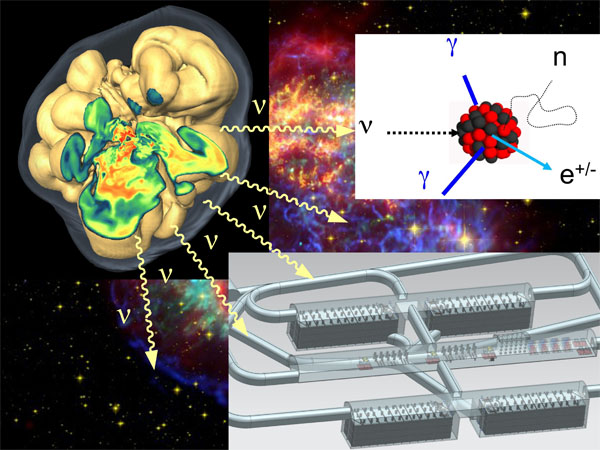
Supernova (SN) neutrinos, as astrophysical messengers, carry unique flavor, time and energy information that may be crucial for understanding neutrino oscillations, the SN explosion mechanism, neutron star properties, and nucleosynthesis. Historically, about 20 electron anti-neutrinos were detected from SN 1987A. Today, Super-Kamiokande and other large water and liquid scintillator detectors like IceCube and JUNO should make detailed measurements of electron anti-neutrinos from the next galactic core collapse supernova. In addition, the large liquid argon detector, proposed for the Deep Underground Neutrino Experiment (DUNE), could add important information on the spectrum of electron neutrinos. Combining the liquid Ar data on electron neutrinos, the water data on anti-neutrinos, and other measurements of mu and tau neutrinos promises a new era where detailed flavor information will be recorded for a galactic SN. This one-week workshop has brought together neutrino experimentalists and experts from the SN modeling community as well as nuclear and neutrino physicists with the goal to develop and assess the needs and the scientific perspectives of a neutrino facility like DUNE.
The more than 40 participants, representing the different subfields and promoting diversity, contributed with talks, discussions, and personal interactions in creating a productive and extremely inspiring atmosphere, filling with life the following agenda for communication and collaboration:
- Detecting neutrinos from the next galactic supernova.
- Neutrino transport in the core-collapse supernova.
- Neutrino interactions in dense matter and neutrino-nucleus cross-sections.
- Neutrino flavor and spin evolution in dense environments.
- Open issues and implications for nuclear, particle and astrophysics.
The one-week workshop was thus intended as a community-building effort, bringing together astrophysicists, nuclear physicists, and neutrino physicists to facilitate preparations for a neutrino measurement of the next Galactic SN with the goal to help maximize the corresponding potential of facilities still in the planning and preparation phase. In particular, the participants discussed the most promising flavor- and time-dependent features of SN neutrino signals and their astrophysical significance; they collected arguments to motivate experimental work for creating the potential to measure SN neutrinos and antineutrinos of all flavors; and they determined the future routes for improvements of theoretical explorations needed to reduce the uncertainties of astrophysics as well as nuclear and neutrino physics.
The main observational targets, identified to either be the most robust theoretical predictions or to have the most exciting discovery potential, include the measurement of the prompt electron-neutrino burst as a signature of stellar core bounce; the multi-flavor measurement of the pre-explosion mass-accretion phase of the newly formed neutron star (NS) and of its characteristic features of hydrodynamic instabilities like SASI (standing-accretion shock instability) or LESA (lepton-emission self-sustained asymmetry); setting constraints by simultaneous neutrino and antineutrino measurements for the nucleosynthesis conditions in the innermost SN regions; the late-time measurement of the neutrino emission from the NS as a probe of high-density nuclear physics not accessible by laboratory experiments; the discovery of a possible phase transition converting hadronic matter into another state (like quark phases); the potential formation of a black hole in the next Galactic core-collapse event, which is currently predicted to happen in possibly up to about 40 percent of all stellar collapse events and would most likely be detected only by neutrinos and gravitational waves; the coordination of measurements with existing and upcoming gravitational-wave interferometers which would provide complementary information of the processes deep in the core of the dying star.
Particularly challenging problems identified by the presentations and discussions include the urgent need of a better understanding of neutrino oscillations in the SN environment, in particular collective neutrino flavor conversions and flavor oscillations in the presence of a turbulent medium. On the nuclear physics side, neutrino interactions in dense media should be studied for better accuracy of SN signal predictions, and better theoretical calculations and experimental measurements of interaction cross sections of SN neutrinos with MeV energies and nuclei like Ar in detector material are highly desirable. For truly exploiting the multi-messenger possibilities of different signal channels in the case of a future Galactic SN, the communication with gravitational-wave experimentalists and, in particular, also with astronomers involved in fast-time scale observations should be intensified.
Discussions during the workshop led participants to organize a new collaborative activity called SNARE: SuperNova Advance Readiness Exercise. The idea is to set up drills in which theorists come up with neutrino fluxes (and other multi-messenger observables) based on state-of-the-art models with physics and astrophysics "treasure" folded into them, i.e., signatures of many of the interesting phenomena discussed at the workshop. The hidden physics parameters could include features specific to oscillations and the mass hierarchy, neutrino spectral feautures of relevance to nucleosynthesis, temporal features related to convection, dense matter opacities and black hole formation, features that reveal astrophysical aspects such as core masses, SASI oscillations, LESA, and other possibilities. Experimental collaborations would then use the provided fluxes to simulate realistic data. The experimenters would then analyze the simulated data to determine capabilities and develop techniques for extracting physics. Furthermore, joint analysis of simulated data would explore what additional information is to be had from combining data sets. This exercise could help influence requirements for design of future detectors, and also build infrastructure for collaborative analysis work. Gravitational wave collaborations and other multi-wavelength observers would be desired participants. Presupernova alert sensitivity would also be worthwhile to explore.
The community-building effort will be continued in a follow-up workshop planned to take place at the Mainz Institute for Theoretical Physics in the week of October 9-13, 2017.


